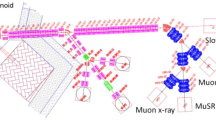Abstract
Purpose
The Experimental Muon Source (EMuS) project proposed at the China Spallation Neutron Source (CSNS) is a facility for muon applications and neutrino physics research. The EMuS target station adopts a superconducting solenoid scheme to meet the requirements of muon and pion capture. The capture solenoid consists of four solenoids with different apertures to meet the requirements of the central magnetic field up to 5T. Due to the high-irradiation environment, the capture solenoid adopts aluminum-stabilized Rutherford cable winding scheme to reduce the heat deposition on the coil. The magnet design considers the degradation of properties of aluminum stabilizer after continuous neutral irradiation. Due to the characteristics of the coil material, the magnet has different steady-state thermal characteristics and quench performance during different operating periods.
Method and result
Through the analysis of the operating characteristics, this paper proposes the design of the magnet structure and quench protection scheme. According to the simulation, the current design can satisfy a continous operating time of 200 days per year.






Similar content being viewed by others
References
H. Chen, X.L. Wang, Chinas first pulsed neutron source. Nature Mater. 15(7), 689–691 (2016)
T. Jing-Yu, F. Shi-Nian, J. Han-Tao et al., Proposal for muon and white neutron sources at CSNS. Chin. Phys. C 34(1), 121–125 (2010)
J. Tang et al., EMuS muon facility and its application in the study of magnetism. Quant. Beam Sci. 2, 23 (2018)
Z. Hou et al., Conceptual Design of the Capture Superconducting Solenoid for Experimental Muon Source, in IEEE Transactions on Applied Superconductivity, vol. 30, no. 5, pp. 1-7, (2020), Art no. 4500107, https://doi.org/10.1109/TASC.2020.2970226.
L. Rossi, M. Sorbi, D. Pedrini, C. Berriaud, I.L. Horvath, Production and qualification of the 60-kA, aluminum-stabilized conductor for the ATLAS B0 coil. IEEE Trans. Appl. Supercond. 9(2), 209–212 (1999). https://doi.org/10.1109/77.783273
B. Blau et al., The CMS conductor. IEEE Trans. Appl. Supercond. 12(1), 345–348 (2002). https://doi.org/10.1109/TASC.2002.1018416
V. Lombardo et al., “Development of Aluminum-Stabilized Superconducting Cables for the Mu2e Detector Solenoid,” in IEEE Transactions on Applied Superconductivity, vol. 26, no. 4, pp. 1-6, June 2016, Art no. 4804105, https://doi.org/10.1109/TASC.2016.2529687.
M. Yoshida et al., Superconducting Solenoid Magnets for the COMET Experiment. IEEE Trans. Appl. Supercond. 21(3), 1730–1733 (2011). https://doi.org/10.1109/TASC.2010.2085410
M. Yoshida et al., “Development of a Radiation Resistant Superconducting Solenoid Magnet for mu-e Conversion Experiments,” in IEEE Transactions on Applied Superconductivity, vol. 23, no. 3, pp. 4101404-4101404, June 2013, Art no. 4101404, https://doi.org/10.1109/TASC.2013.2238276.
Y. Yang et al., “Study of Irradiation Effects on Thermal Characteristics for COMET Pion Capture Solenoid,” in IEEE Transactions on Applied Superconductivity, vol. 28, no. 3, pp. 1-5, April 2018, Art no. 4001405, https://doi.org/10.1109/TASC.2017.2777848.
M. Yoshida et al., Low-temperature neutron irradiation tests of superconducting magnet materials using reactor neutrons at KUR. Proc. AIP Conf. 1435, 167–173 (2011)
Cryogenic Material Properties, 2016. [Online]. Available:https://www.nist.gov/mml/acmd/structural-materials-group/cryogenic-material-properties-index
Acknowledgements
This work was supported by the National Science Foundation of China under Project 11527811.
Author information
Authors and Affiliations
Corresponding author
Rights and permissions
About this article
Cite this article
Xie, Z., Zhao, G., Zhu, Z. et al. Analysis of thermal characteristics for EMuS capture solenoids. Radiat Detect Technol Methods 5, 542–549 (2021). https://doi.org/10.1007/s41605-021-00276-3
Received:
Revised:
Accepted:
Published:
Issue Date:
DOI: https://doi.org/10.1007/s41605-021-00276-3




